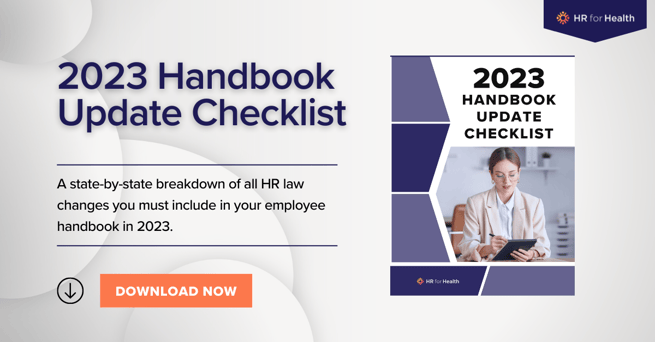The Ultimate Guide to HR Forms: What You Need and How to Find Them

Your practice is always buzzing with new patient intake forms, follow-up calls to stay connected, and back-to-back appointments. Whether you’re running a veterinary practice, an optometry practice, or a chiropractic practice, HR tasks (from recruitment and onboarding to performance reviews and termination) tend to take a backseat to the more pressing tasks at your desk. However, HR processes and HR forms are vital for keeping your practice in compliance with state and federal laws, and the smallest oversight could have severe consequences, including costly fines and loss of valuable employees.
For example, if you hire a new employee during a busy season and throw them into the mix trial-by-fire style, you immediately know what type of person you’re dealing with, and they very well could become a candidate for promotion. Yet if you didn’t have them sign an I-9 form during their onboarding process, you may also receive a fine from the Department of Homeland Security (DHS) ranging from a couple hundred dollars up to several thousand dollars for that single missing document. When completing the wide variety of HR processes, , there’s simply no room for error.
In This Article:
⦿ The Benefit of HR Forms and Templates
The Benefit of HR Forms and Templates
Having an arsenal of HR tasks and processes to consider can be daunting, so it is helpful to set yourself up for success by utilizing forms and templates that meet regulatory requirements. Forms take you from staring quizzically at a blank page on your computer to quickly filling in pieces of information as prompted by a template. Running a health practice gives you enough to think about on a regular basis, and with HR forms, you can remain compliant without having to rack your brain. There is never a shortage of reasons why you may require HR forms. With this comprehensive list, you’ll always have somewhere to turn when the inevitable happens. 
You need HR forms from the moment you start recruiting employees up until termination. With a quick online search, you can find bare-bones templates that may seem convenient but are usually not completely compliant. With HR for Health, you’re provided with all the forms you need and you’ll never have to add extra clauses to ensure compliance.
During the recruitment process, you need to gather information using an application form, you need their authorization to run a background check, and you need to solidify a contractor agreement or offer of employment. Additionally, any drug tests should be administered by a third party. Each process requires a set of forms that can only be streamlined with standardized workflows. Once they’re on board, your new hires need work schedules and vacation schedules clearly outlined—plus, payroll setup requires a direct deposit authorization form. Your payroll process should be set up in alignment with state laws for each of your employees and that includes providing detailed paystubs. You can make your life easier with the perfect setup only HR for Health can offer.
During an employee’s time with your practice, they may need to report an incident or submit a complaint form. These HR forms may need to be further substantiated with a compliance and investigation report, and a follow-up checklist that provides a clear paper trail. HR forms are lifesavers in any one of these instances, because half the work is already done for you.
Updated Your Employee Handbook with the 2023 Handbook Update Checklist.
Recruitment
Recruitment functions incorporate several phases before and during employment with your practice. You typically begin with a job posting that alerts job seekers of the open position. Each practice identifies their own hiring process, which may include a working interview, to ensure they select the right members for their team. . No matter the position you’re hiring for—whether it’s a veterinarian technician or a receptionist, you should have a clear job description form that thoroughly covers job responsibilities for your potential new hire.
When an employee knows upfront what their job responsibilities are, you don’t have to waste time interviewing people who don’t have the experience or schedule availability you require. Your interview process may start with a phone or video call and move to an in-person interview. You may decide to have multiple team members sit in for the interview, depending on the position you’re hiring for. With HR for Health’s job interview questions, employment application, and done-for-you job descriptions, this process is guided and simplified.
When you decide to move forward with a candidate, you should provide them with an offer letter, and when they accept the offer, you can transition to the onboarding phase. Start with a new hire document checklist to ensure you don’t miss a single document and be sure to keep all HR documents stored in a secure, centralized location for easy access when needed. HR for Health is equipped with the infrastructure to store all your electronic files, saving you time from having to do this yourself
Your new hire checklist keeps you on track to ensure you’re meeting all state and federal requirements. Aside from the initial onboarding forms, you may require a working interview template and eventually termination forms when it’s time for a team member to move on. You’ll need an employee contact form that outlines the name, address, and emergency contact information of your new hire, along with a welcome email that sets them up with any usernames, passwords, and intranet access they require. When you need to issue assets like uniforms, keys, or any electronics, you can customize your new hire checklist to ensure all steps are followed properly. When it comes time to terminate an employee, you’ll also require another set of HR forms, including a termination letter, an employee exit interview template, and a reference letter if the separation is on friendly terms.
To customize a recruiting process, you can set aside practice-specific documents and put together a plan for all future recruitment procedures. Your HR forms may include the following: 
- Recruiting Plans Forms & Templates
- Staffing or Recruiting Plan
- Recruitment Process Documents
- Intern Agreement Template
After the initial recruitment phase, you’ll require an employment application for candidates to fill out along with job description forms that definitively outline the requirements of the position, such as:
- Job Descriptions and Applications Forms & Templates
- Job Description Template
- Job Description Document
- Employment Application Form
To keep your interview process streamlined, you can keep interviewing templates on hand like the ones listed below, along with other HR forms to keep your hiring process on track, including a document for checking references and an authorization for running an employee background check.
- Interviewing Forms & Templates
- Interviewing Forms & Templates
- Sample Job Interview Questions
- Interview Evaluation Form
- Employee Background Check
- Checking References Document
- Job Interview Rubric
When you’ve found the ideal candidate, you can move forward with an offer letter, temp offer letter, or working interview letter to set up clear expectations and identify their start date and pay details.
- Hiring Forms & Templates
- Rejection Letter Template
- Offer Letter for Regular Employees
- Offer letter for Temporary Employees
- Working Interview Letter
Once your candidate has accepted your offer, keep your new hire checklist handy to ensure they are provided with all required access and assets pertaining to their new position. Examples of onboarding resources you may need include the following:
- Onboarding Forms & Templates
- New Hire Checklist
- Employee Onboarding Checklist
- New Hire Welcome Letter (Supervisor)
With every start comes an eventual ending. When you or your employee decide it’s time to part ways, you’ll require termination forms, including an employee exit interview, to complete their employee file and document their departure.
- Offboarding Forms & Templates
- Termination Letter Template
- Termination Forms
- Employee Exit Interview
Payroll and Scheduling
Payroll and scheduling require a different set of requirements/responsibilities, particularly if you hire seasonal or part-time employees. Part of your responsibilities when administering payroll includes updating employee data in the system, including their hourly rate along with their personal information. Additionally, you’ll be required to calculate deductions, including taxes and any benefits you offer.
Employee timesheets keep your employees accountable with their hours and keep you informed on hours worked. Employee attendance is a central aspect of your practice, and having an accurate timekeeping method in place can help you make decisions that minimize the number of times you’re short on help.
For payroll, you’ll want to consider issuing checks via direct deposit to minimize paperwork, and you will want to obtain written authorization from your employees to do so. Utilizing a standardized direct deposit authorization form and compensating your employees via direct deposit helps your employees get paid more quickly than they would with paper checks. You can also have an employee expense tracking worksheet to keep your employees organized with any office expenses.
For example, if your office manager is tasked with buying treats for animals that visit your veterinary practice, they can use an expense tracking sheet that allows for timely reimbursement.
With every employee check, you may also be required to have a pay stub that clearly outlines several pieces of information, including the employee’s information, their hourly rate, their allowances, their deductions, and their year-to-date information.
Following is a list of documents that may be helpful to have:
- Scheduling Forms and Templates
- Employee Work Schedule
- Employee Attendance Tracker
- Time & Attendance Forms
- Employee Timesheet
- Payroll Forms and Templates
- Direct Deposit Authorization Form
- Expense Reimbursement Form
- Payroll Forms
- Pay Stub
Employee Relations
As your employees continue to evolve in their roles, part of your HR responsibilities include managing employee relations. You need access to HR forms that help resolve conflicts and disputes. Since these scenarios can be delicate, it’s always best to be prepared with a full set of HR templates that help you document any incident that arises. For example, if an employee begins to struggle with absenteeism, you can turn to their employee work schedule and time and attendance forms to remind them of the commitment they signed on for. You can also consider disciplinary action, which allows you to keep a written record of your attempts to reconcile the issue with your employee.
Physical therapy practices, dental offices, and chiropractic practices all house equipment specific for use with their patients. Due to different types of equipment throughout your practice, you may have an employee who suffers an injury. It could be something as simple as tripping over a physio ball or tripping over a cord plugged into the wall. If something like this were to occur, medical attention could be required, and follow up paperwork is always a must. 
You are required to keep up to date with Employment Opportunity Commission (EEOC) and harassment laws as well, including all procedures around them so that your practice has a clear paper trail regarding any incidents and complaints. Keep a complaint template ready for use that aligns with required procedures and make sure you can easily access any notes in the employee’s file should you require them at a later date.
The employee should always be able to submit a formal complaint, especially if it’s related to sexual harassment. Though no one looks forward to using a form to report an incident of sexual harassment, when you have these HR forms on file, you can quickly spring into action with an investigation report. The employee who engaged in the harassing language or treatment requires disciplinary action and may even need to be terminated on the spot. With a compliant process in place, including compliant documentation such as the examples listed below, you can fully substantiate any termination decisions you take, instead of relying on verbal complaints or an email thread.
- Incident Report Template
- Complaint Forms
- Investigation Forms & Templates
- Disciplinary Action Forms
- Disciplinary Procedures
- Disciplinary Action Form
Training & Development
To maintain forward momentum with your team, you should also provide feedback and training to help your team advance both personally and professionally. Lack of adequate feedback, encouragement, and continuous training can lead to complacency, which can also lead to a lack of productivity. Although lack of continuous training impacts your employees, it also impacts your practice. Some training requirements are mandatory to keep you in compliance. For example, harassment training in California is required every two years. To enrich your employees’ lives during the time they work in your practice, you can provide training and encourage goal-setting to keep morale high and keep your team thriving. HR for Health provides you with performance plan templates that set the tone for development plans and keep both you and your employees aligned with growth.
When training and development is well managed, not only do you improve efficiency across the board, but you also improve employee retention. Finding the right fit can be time consuming and costly, and keeping your team happy and on board with your practice takes some special attention —
Implement a process for goal setting to keep your team focused on improvement, and be prepared for introductory, interim, and annual performance reviews. Your team may have their perspective on their performance, and when you provide them with the opportunity to complete a self-assessment, you get a look at how the employee views their own performance. Having that info allows you the opportunity to prepare for the performance review conversation. It also provides you with the kind of information that helps you understand achievements that you may have overlooked.
For example, if your receptionist has taken it upon herself to create a system or process that streamlines patient check-in, this is an example of taking initiative and it is worth celebrating and rewarding. On the other hand, if your office manager has failed to keep records accurate and up to date, you may need to revisit the process, set a goal for improvement, and set up a follow-up performance conversation to ensure any agreed upon actions have been taken. Without regular feedback, your team loses a sense of direction and engagement.
- Training and Evaluation Templates
- Goal Planning
- Training and Development
- Performance Management
- Performance Review Forms and Templates
- Employee Performance Review
- Performance Review Template
Workplace Safety & Policies
Especially in a healthcare practice where equipment, medication, and tools are present, safety policies must be expressly written with follow-up procedures in place. Without safety policies and procedures clearly outlined, employees may create their own procedures in the case of an emergency, which could lead to poor decision-making, which puts your team and any one else in your office in danger.
For example, instructions around office safety protocols such as temperature checks may seem minuscule, but providing these safety procedures to your employees at the start of their employment keeps them abreast of proper protocols that keep everyone safe. Similarly, knowing how to handle an emergency requires a proactive plan of action that your team can follow, instead of relying on reactive instincts.
Part of safety also means ensuring your employees are sober when they’re in the workplace. A drug testing consent form your employee signs when beginning employment may have a clause that authorizes drug testing to be performed when there is reasonable suspicion that the employee is under the influence and their performance is impaired, especially following an accident or other unusual incident. It’s not recommended you execute drug testing on your own, rather that you use a reputable third party facility. 
Your workplace safety policy has some general information, and you can customize it with specifics related directly to your practice. Your handbook policies also contain your sexual harassment and violence prevention policies, which your employees should thoroughly read and sign their acknowledgment. HR for Health makes this easy with electronic records. With just a few clicks, your employees can catch up with all their required signatures.
COVID-19 has brought with it a whole new set of safety procedures, each of which should be carefully outlined to ensure the safety and comfort of both your employees and the patients you treat. These steps toward safety help secure your office environment while keeping employees accountable for their actions. For ease of access, keep your HR documents organized by storing updated safety policies related to COVID-19 in a separate file than your regular employee handbook. Use the uploading and organization features of HR for Health to keep this process simple.
- Workplace Policy Templates
- Drug Testing Consent Form
- Workplace Safety Policy
- Dress Code Policy
- Social Media Policy
- Workplace Sexual Harassment Policies
- Workplace Violence Prevention Policy
- Other Forms & Templates
- Grievance Procedures
How HR for Health Can Help
Keeping your practice in compliance with HR laws, careful organization, regular follow-ups with employees, updated paperwork, and open channels of communication are essential. There is a lot to consider, including legal risks and state and federal law compliance. While there is the cut-and-dried aspect of HR, as noted with the HR forms listed above, there are also more nuanced practices that require your watchful attention to detail.
For example, while employee performance reviews can help you and your employee gauge current performance and create a forward trajectory, on-the-spot praise and encouragement can boost employee morale and improve retention. Solid HR processes around documentation keep you organized, and HR is about much more than documentation. The human element ultimately sets your practice apart—both for your patients and your employees.
If you’ve been trying to manage HR on your own, we commend you. We know it’s not an easy task. With HR for Health, you have a team to turn to who helps with live onboarding, ongoing HR support, and intelligent software that automates and streamlines many processes outlined in this article, including employee relations and payroll. Make payroll a two-click process and employee relations a breeze with HR for Health’s intuitive software. Your chiropractic, optometry, veterinary, or dental practice functions better when you’re well-supported on all sides of HR.
Minimize risks, handle employment claims with ease, save time, and improve your office culture—all while you bring your focus back to the reason you chose your career in the first place: your patients. Find out how HR for Health can simplify your HR department and help you keep thriving. 
About HR for Health
HR for Health is one of the nation’s leading Human Resources Management Systems (HRMS) used by small to mid-sized practices. HR for Health is an all-in-one HR software solution dedicated to helping the dental, optometry, and veterinary industries. Our human resources platform features all the tools practice owners need to manage payroll, timekeeping, 401(k), and more with total integration and ease.
Whether you’re looking for HR support for a small business or you’re a large group dental practice, HR for Health has the solution to fit your practice and budget. Reach out to an HR for Health account representative to learn more, today: Book Time Here.
.png?width=300&height=92&name=NewHRFHLogo%20(1).png)
